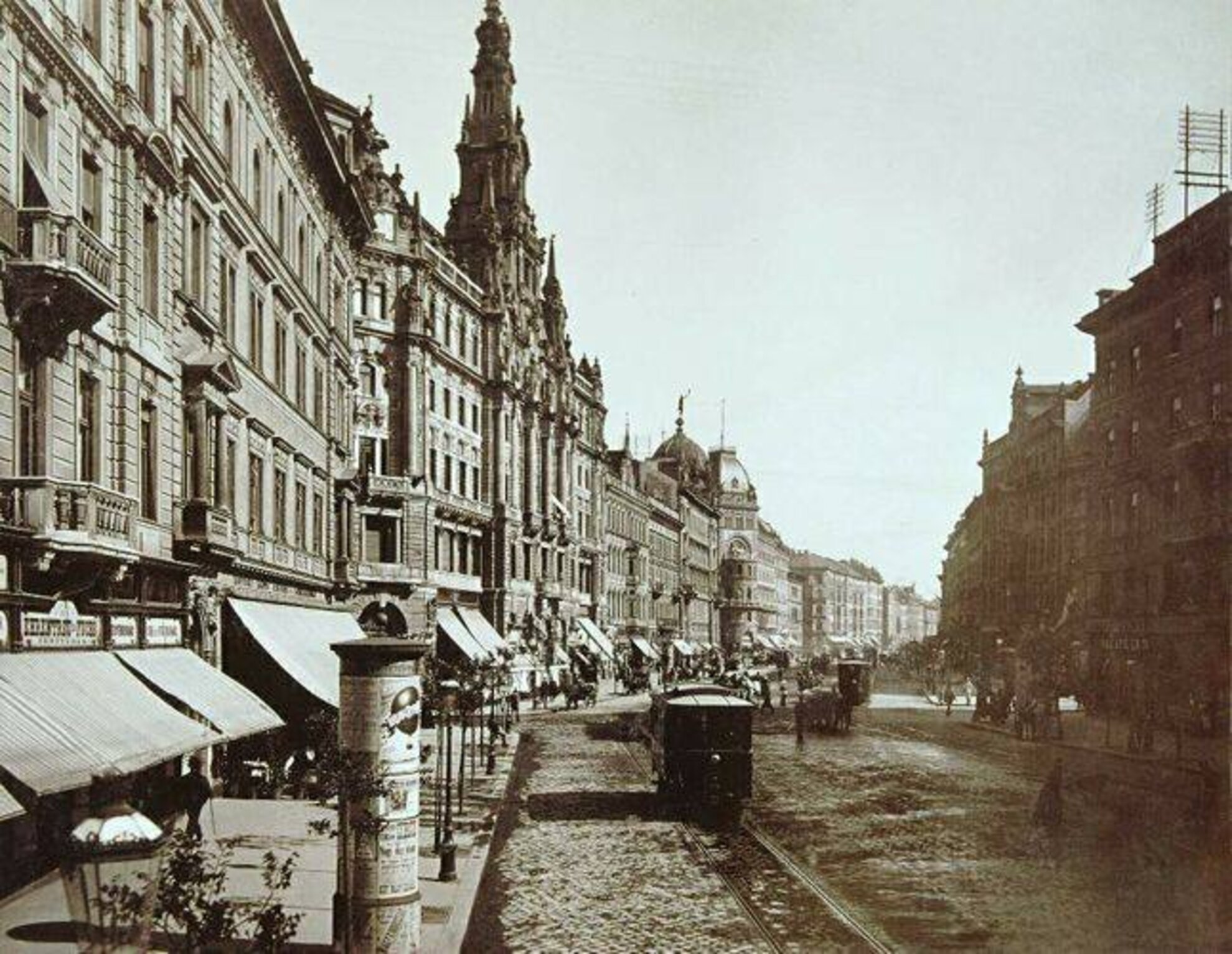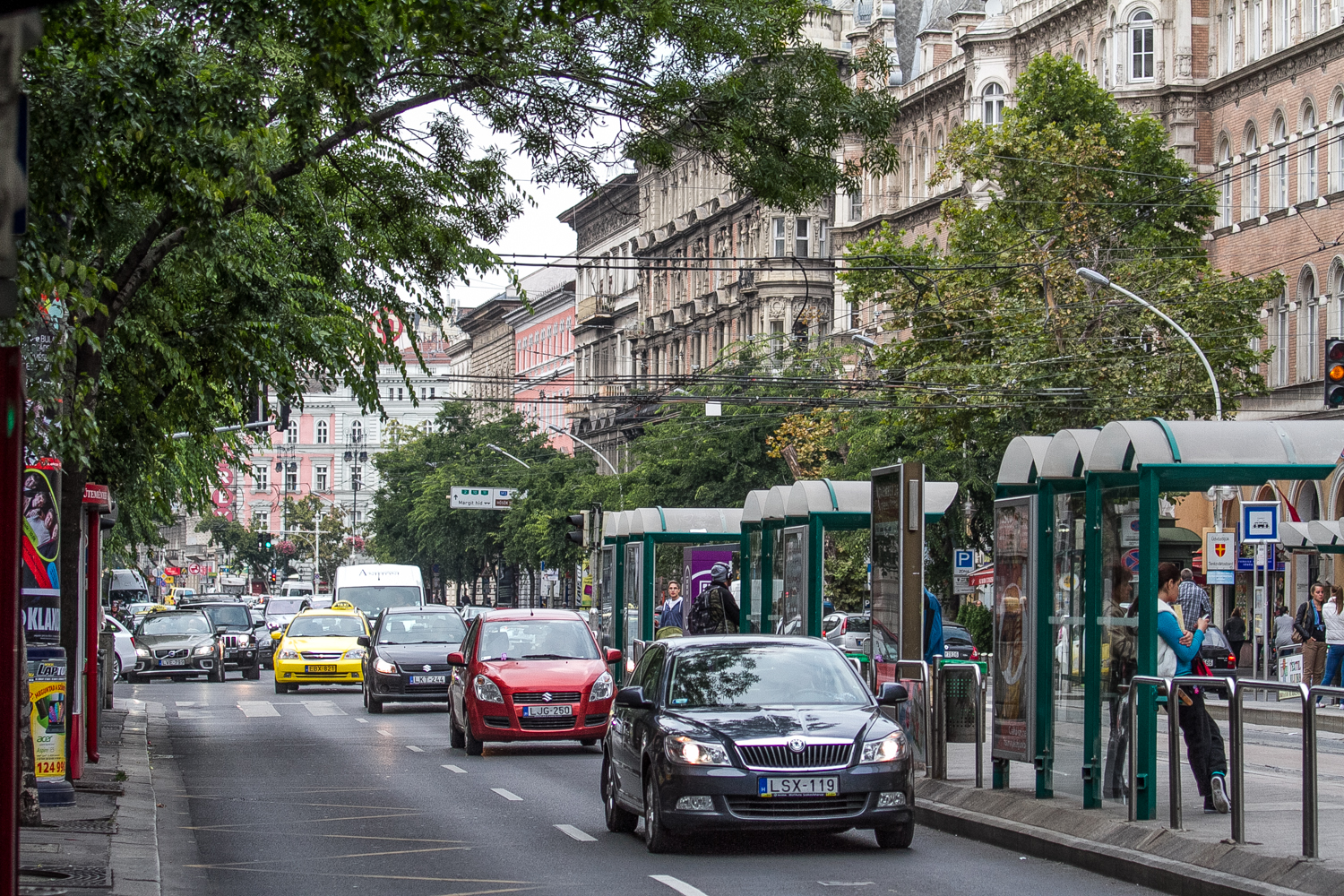What’s known as the “Big Ring Road” forms a 4.5-kilometer-long semicircle in Pest (although the road itself continues into Buda). Our journey on foot takes about two hours and cuts right through the inner city from Petőfi Bridge to Margaret Bridge.
Construction of the Nagykörút began in the 1870s and 1880s, so this road is a mix of beautiful old buildings combined with gritty modern developments. The image below shows what the road looked like in 1896.

Ferenc körútAs we start walking along what is collectively known as the “Nagykörút” at the Petőfi Bridge end, we’re actually on the Ferenc körút section. Each section has its own name: József körút, Erzsébet körút, Teréz körút, and Szent István körút. If you are wondering what these names mean, Szent István is Saint Stephen – the founding king of Hungary – and the rest were all subsequent monarchs. Interestingly, the Teréz and Erzsébet sections were renamed to honor Lenin from 1950 to 1990.
Starting at the Pest end of Petőfi Bridge, we look over on the left to Nehru Bank – behind this park looking out onto the Danube, the Bálna Budapest complex (AKA whale building) looms. Where the Nagykörút begins is Boráros Square, while there’s not much to see here, it is a frequently used transit hub. It’s worth looking at the façades of the beautiful buildings right along this entire walk. There are many examples of architecture dating back to the late 1800s, and the design and decorations that adorn these apartments and offices is often stunning – even if many façades are in desperate need of restoration, or just a good cleaning.
As we continue, we soon cross Radáy Street – a popular pedestrian-friendly street lined with many restaurants offering tasty traditional Hungarian dishes. About ten minutes later we reach Corvin Negyed, or "Corvin Quarter" – the area at the intersection of Üllői Road, identified by a metro station here (blue line M3). On the left before the intersection, we see a beautiful big Art Nouveau building with a green tiled roof, built in the 1890s. This is the Museum of Applied Arts, housing a collection of intricately designed furniture, textiles, glass, and much more. The building itself (see below) is worth seeing inside and out.
At the opposite corner of the intersection is the Corvin Cinema, which is in continual operation as a movie theater since 1922. One of the most important events in Hungary’s recent past took place in this area – during Hungary's 1956 Revolution against Soviet occupation, the Hungarian freedom fighters established a guerrilla barracks here at Corvin köz, where the so-called “Pest boys” held out against an onslaught of tanks and artillery for many days, armed with only basic weaponry and strategy. Here statues commemorate these young men and their ill-fated struggle.József körútA new feature along the Grand Boulevard is the recently opened Metro 4 – one of its stops is at the recently renovated Rákóczi Square, and from the street you can see the modern look of this new station that includes a reflecting pool. Incidentally, the tram tracks where lines 4 and 6 run along the Grand Boulevard are among Europe’s busiest.On the way to Blaha Lujza Square, it’s worth checking out the beautiful façade of the Hotel Nemzeti, which originally opened in 1896 and is now newly refurbished and welcoming guests again. It was built as one of the city's most modern hotels, and even had Budapest's first elevator.Blaha Lujza Square is actually one of Budapest’s busiest intersections, and is named after a beloved Hungarian singer. On the left is the Corvin Mall – the façade might look quite hideous, reminiscent of an aluminium “box”, but behind it remains the façade of a grand old department store that opened in 1926.
This plaza was Budapest's first big department store, and it held Budapest’s first escalator. It’s hard to imagine now, but this was a popular spot with locals who would even come to see the new season’s clothes being unveiled in the windows. The building now houses the Corvintető nightclub on its rooftop.
See the old façade in the black-and white-image below.
The big empty space in front of the Corvin Mall was where the National Theater stood between 1908 and 1964. It was blown up to make way for construction of the red line M2 stop, and today that area is an open space bustling with foot-traffic.
As we continue up the Grand Boulevard from Blaha Square, on the left we pass the building that once housed the EMKE café and bistro (see left corner of image below), which was one of the city’s most popular and well-known eateries; many locals still refer to this building as “EMKE”.Erzsébet körútParticularly along this stretch, the entire road is dotted with dodgy bars, sex shops, fast-food eateries and the like, but juxtaposed against this shady milieu liess one of Budapest’s most glorious eateries: the world-famous New York Café. This café is 120 years old, and its stunning interior – replete with gilded fixtures, gleaming mirrors, and gigantic ceiling murals – is a must-see.
Budapest's thriving art-house cinema scene
was largely centerd on
this grand thoroughfare, with the Hunnia, Kino, Örökmozgó, and
found along the entire stretch, but unfortunately not all are operating as cinemas today.
Nearby we find the Madách Theater, which moved to its current location in 1961. It mainly stages
musicals, and
some are
presented
with English subtitles.Soon we see the luxurious Corinthia Hotel Budapest, which first opened its doors way back in 1896 as the Grand Hotel Royal. It was the first place in Budapest to show a motion picture, and some even say the fictional lodgings in the recent Grand Budapest Hotel movie presents uncanny similarities to this hotel.
While we're not sure if this is a work of fiction too, one of the most interesting stories about the Grand Boulevard is that there were plans for it to become a water-filled canal to give ships from the Danube easier access to drop off their cargo in the city.
Soon enough we hit Király Street, and this means we’re more than halfway through our journey. This famous street passes by Kazinczy Street and Gozsdu Udvar before arriving at Deák Ferenc Square.
But don’t leave us in search of a ruin pub just yet – there’s much more to see on this walking tour.Within about five minutes we reach the great intersection that is Oktogon, one of the city’s busiest traffic crossings, named for its octagonal layout. There’s an underground metro stop here on the yellow M1 line – this is continental Europe’s first subway line. Twice in its history Oktogon has been renamed; once as Mussolini Square and once as November 7 Square (a significant date of the Russian revolution).
This intersection crosses the world-heritage listed Andrássy Avenue. Turning left down Andrássy we’d eventually hit Erzsébet Square, while heading the other way would take us to Heroes’ Square and City Park. The area at Oktogon was a big hole in the ground prior to 1871, but during the construction of Andrássy Avenue, this hole was filled in and the four major buildings that make up Oktogon's shape were created. The sepia image below was taken in 1896.Teréz körútThis next stretch continues to have a grungy feel, but it continues to be worth paying attention to the architecture of the area. There are many incredible buildings in this area, including the Nyugati Railway Station, planned by the Eiffel Company and opened in 1877. The Eiffel Square that flanks one side of the train station provides much-needed green space.
The West End mall is on the Nyugati’s other side. To get over to the next section of the Grand Boulevard, head down through the underpass; read more about these subterranean passageways here.
It’s incredible that the construction of so many of Budapest’s buildings took place in the late 1800s, and that much of the city’s main features look now as they did some 120 years ago. The Grand Boulevard is the perfect example of how grand old buildings mesh with modern changes. The black-and-white image below shows the Nyugati station around the 1900s.Szent István körútThe last stretch of the Grand Boulevard takes us back to the Danube, but we still have yet to admire the grand yellow Vígszinhaz theater and Jászai Mari Square (named after a Hungarian actress), where there are many nearby shops and restaurants to enjoy. Falk Miksa Street – a charming lane lined with trees and galleries – begins from this square and stretches all the way to the Parliament House.
Finally, we reach the newly renovated Margaret Bridge, presenting stunning views of the city. From here it’s either time to explore Margaret Island, view the evening lights of the Hungarian Parliament, or continue across to Buda. Alternatively, jump aboard a tram and head back to the heart of Pest.




